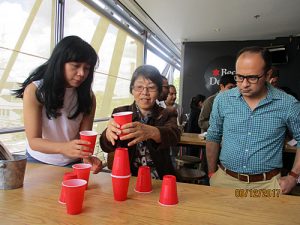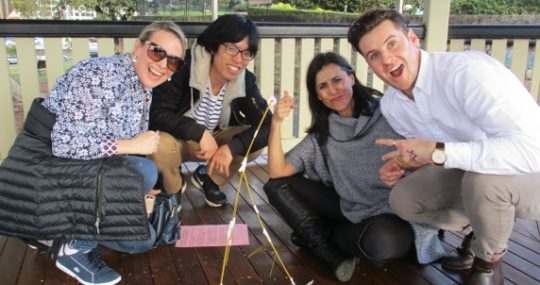How to make team building better for introverts, plus loads of great icebreaker ideas
Well chosen icebreakers and games accelerate your efforts to build a positive culture by stimulating cooperation, participation and comfort within the group. Plus they can be a lot of fun.
- Create a positive mood.
- Help a new group get to know one another.
- Help new team members to integrate.
- Help people feel comfortable together.
- Encourage trust and cooperation.
- Encourage people to break out of their cliques and include others.
- Develop team member’s social skills.
- Level hierarchy and build rapport between leaders and team members
- Create a safe environment for learning and participation.
How to Make Team Building Better for Introverts
.
.
These suggestions are extracted from my longer post that delves into how leaders can harness the full potential of their introverts in a team environment. (I talk about how to build a culture that is “introvert considerate” of AND empowers them to overcome their social unease and participate to full capacity).
5 aspects of team building games create unease in some introverts and need to be managed with a light touch; noise and chaos, feeling forced to reveal personal information, being put on the spot, physical touching and dealing with the energy of a large group of people. Let’s consider an approach to manage each of these:
.
Facilitator’s Tip: Don’t force participation. Be calm and positive, always invite – never force – anyone who seems reserved to take on a role in the spotlight. (You will no doubt have noticed the loud mouth, who is up for being the centre of attention straight away.) Routinely offer praise and reward for anyone who steps forward as that is a social risk (especially in the early stages).
.
How to Deal with Sceptics
.
Facilitator’s Tip: After 12 years in the team building space my best advice is not to tackle sceptics head on. At Team Bonding we let them be and focus our attention on the enthusiastic participants. We have tactics to reward people who are highly engaged and encourage them to model this for the other people. The one instruction is that the whole team be involved in completing tasks, which allows teams to organise themselves. If people choose to be obstructive it does get noticed and they’ll often self correct. It helps a lot when you have tried and tested all your events and eliminated anything that people find “lame” or too silly :-).
..
Congratulations, once you’ve considered the needs of ALL your teammates in your choice of activity you will get a better result.
*********************************************************
.
Introduction Phase / Icebreakers for Small Seated Groups
.
>> the length of time you expect each person to speak
>> the vulnerability or intensity of the comment (early stages is not the time to encourage vulnerable sharing).
1. Ask a question of each participant which yields a simple, short story:
Tell everyone something about yourself that not many people here would know. Tell everyone the best thing that happened to you this week. A twist on this is what is your “secret skill” or what super power would you choose to have? (Kind of like this idea but not sure? See a variation below)
.
2. Ask people to bring an item along (good for those who like notice) or source and item from their desk, wallet, handbag etc. You can tie the direction into the goals of the workshop or meeting.
Bring an item that represents motivation to you. Bring an item that represents inspiration for you. Bring an item that represents creative thinking for you. Bring an item that represents problem solving for you.
.
3. Gamify the Introduction
.
Game 1: Two Truths and One Lie (variation).
2 truths and 1 lie is a popular game, but it has a couple of drawbacks for individuals, as some people feel put on the spot and it can take a long time. An variation which overcomes both issues is to put people into groups of 3 and give the trio 5 minutes to come up with their two truths and one lie. When ready, go trio by trio with each person calmly stating either their truth or lie. The rest of the group has to figure out who is telling the truth and who is lying. (Depending on time, you can allow each person to be asked one additional question by the other teams). This is great for the original trio to laugh and bond whilst deciding on their truth and lies. You will need to allow 20+ minutes for this game, but it can be a lot of fun.
.
What super power would you choose?
Next level: You could play excerpts of the songs or make a slide show the TV shows. You could even make a playlist of the songs to play during breaks!
.


Favourite place
First car
Favourite food
Middle name
Best podcast
Postcode
Number of siblings
Not a Game, An Injection of Motivation:
A very different approach, for teams who’ve worked together for some time and perhaps have external (not internal) obstacles, try the Positivity Game.
Tape a sheet of paper to everyone’s back give everyone post it notes. Ask everyone to write a positive word or phrase for every team mate and stick it onto their back. You will be amazed at the intensity of the comments, it is marvellous to build confidence and a sense of belonging in the team, many teams (even sceptics) find this the most rewarding team exercise ever.
Energizer Games to break up an Agenda and Promote Teamwork – Smaller, seated groups
(Super quick energizer) Give everyone a piece of paper and ask them to quickly tear a map of Australia, then vote on whose is best
A simple team building exercise that is enjoyable but has implications for innovation, design thinking, inclusiveness, leadership process, agility and other valuable attributes. I have a separate post on this one here:
And here is an excellent You Tube video about the exercise.
.


If you have some space in the room, Minute to Win It games are generally popular, choose those with easy props that you can test beforehand. (we use several of the cup games in our events)
Top 10 Games are Here: https://www.youtube.com/watch?v=qebYuCt5zJg
https://www.youtube.com/watch?v=SntkcQIYXUk
.
*********************************************************
Games to break up an Agenda and Foster teamwork – Larger groups
Facilitator’s Tip: – For these games you need cleared space to move around, if you don’t have this, see this post here about game for a seated group:
Game 1: Human Bingo
Examples of interesting things to put in the grid
bilingual
loves ice hockey
has two or more pets
is a twin
is left handed
is a youngest child
has been more than 10 years at the company
has a masters degree
loves heavy metal
Game 2: Evolution using Rocks Paper Scissors
A simple, quick and fun energiser is Evolution. Starting as “eggs” only 50% of people advance the the next level by winning a round of rocks, raper, scissors. This game can be played outdoors or in a large cleared space. If indoors, tape off the sections with masking tape.
Here is a PDF of some instructions for this easy, fun game.
Game 3 – Would You Rather …..
Another fun, energising game. Ask a simple question and have people run (or scamper) either north or south, east or west in a cleared space. It’s all about making quick decisions.
Coffee or Alcohol?
Back to life; Princess Diana or Prince?
This one is “deeper” and could work well for a session about mission. Based on a groundbreaking experiment run in Denmark to build a more cohesive society, this can be used as inspiration for your own activity. Watch the All that We Share YouTube clip first
The format is so arresting, it could easily be adapted to suit a large group and a work culture. You would need to think carefully about the questions, start with light questions so you don’t intrude on people’s personal lives, but build into passion, purpose and values. You could use potentially common life experiences, starting with positive life experiences like travel, study, learning music, playing sport etc and move into some with depth (that aren’t overly stigmatised) such as having aging parents, losing a beloved pet, having to move away from friends, struggling with an illness or injury.
(It is meant to be profound and there is an element of courage required, but I would counsel against getting political and steer clear of some of the very personal examples in this video, such as those relating to sexuality, sexual relationships, mental health or pregnancy. That said, this is potentially very powerful for building empathy in your team and recognising the common humanity of everyone).
Here is another example of All That We Share (for a School)
Here is another example (note they often start with “Class Clown” as that is the person most equipped to step forward).


